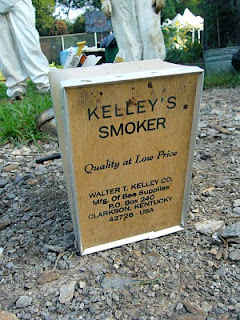



 I've just started a position at Beardsley Community Farm through CAC/Americorp and will be working on there for the next ten months. Knoxville has a great resource in Beardsley. It is a twelve-year-old urban teaching farm on the site of the former Beardsley Junior High in Mechanicsville. Volunteer workers grow fruit, vegetables, herbs, flowers, and help tend six chickens and four bee hives. The produce is donated weekly to three food kitchens in Knoxville and volunteer gardeners are welcome throughout the workweek, M – F, 8 - 4 pm.
I've just started a position at Beardsley Community Farm through CAC/Americorp and will be working on there for the next ten months. Knoxville has a great resource in Beardsley. It is a twelve-year-old urban teaching farm on the site of the former Beardsley Junior High in Mechanicsville. Volunteer workers grow fruit, vegetables, herbs, flowers, and help tend six chickens and four bee hives. The produce is donated weekly to three food kitchens in Knoxville and volunteer gardeners are welcome throughout the workweek, M – F, 8 - 4 pm. We began by covering our bodies in bee suits (or long sleeves and pants), long gloves, and veils. Pam started a smoldering fire in her smoker and we approached the hive. The smoke signals to the bees that their hive may be threatened by fire. In response to the perceived fire and the possible evacuation of the hive, the bees gorge themselves on honey. Bees full of honey are like Americans full of turkey on Thanksgiving-- pacified and less active.
We began by covering our bodies in bee suits (or long sleeves and pants), long gloves, and veils. Pam started a smoldering fire in her smoker and we approached the hive. The smoke signals to the bees that their hive may be threatened by fire. In response to the perceived fire and the possible evacuation of the hive, the bees gorge themselves on honey. Bees full of honey are like Americans full of turkey on Thanksgiving-- pacified and less active. We carried the honeycombed frames into the barn and closed the doors to keep the bees out. There we used a heated knife to slice through the capped comb. It was satisfying to shave off big slices of wax and watch them ooze into the bin below. After the comb was opened we fixed the frame inside a large metal barrel that flings the honey out of the comb like a salad spinner dries lettuce. As the honey was spun out it drained from a spigot at the base of the barrel through a metal mesh screen and into a nylon bag tucked into a five gallon bucket. After the spinner finished draining, we gathered up the nylon bag to strain the honey through its finer mesh.
We carried the honeycombed frames into the barn and closed the doors to keep the bees out. There we used a heated knife to slice through the capped comb. It was satisfying to shave off big slices of wax and watch them ooze into the bin below. After the comb was opened we fixed the frame inside a large metal barrel that flings the honey out of the comb like a salad spinner dries lettuce. As the honey was spun out it drained from a spigot at the base of the barrel through a metal mesh screen and into a nylon bag tucked into a five gallon bucket. After the spinner finished draining, we gathered up the nylon bag to strain the honey through its finer mesh.
A friend tipped me off to these agriculturally themed matchboxes from Czechoslovakian circa 1950ish. They're a great example of the optimism surrounding the integration of agriculture and industry.
You can see more of the matchboxes at graphic designer, David Pearson's flickr stream here.